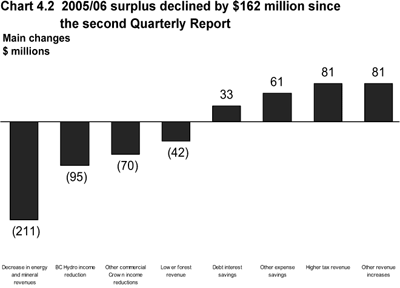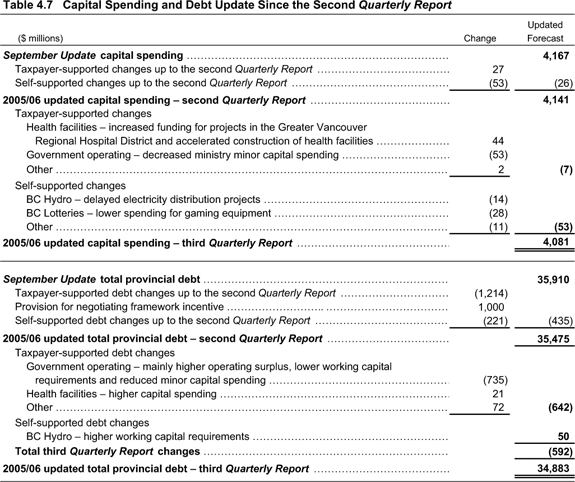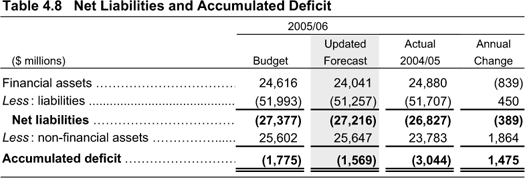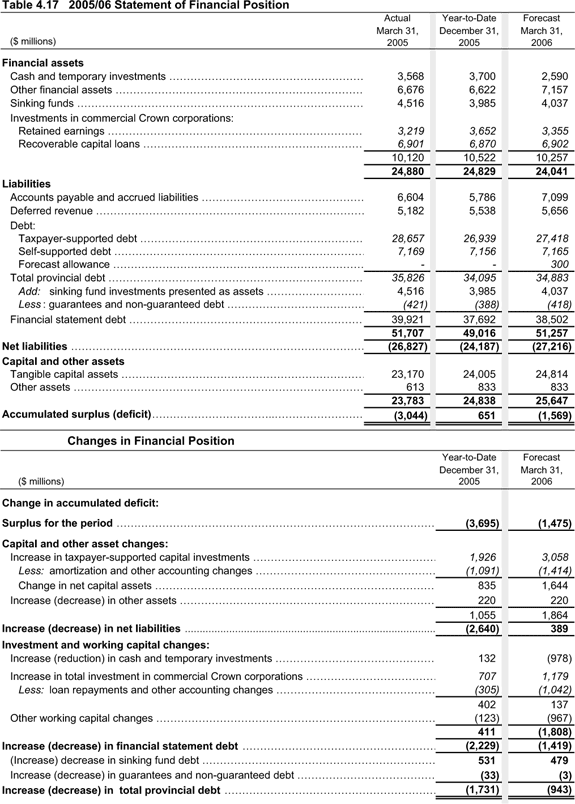Part 4: 2005/06 Updated Financial Forecast
(Third Quarterly Report)
2005/06 Fiscal Year in Review
The government’s surplus for 2005/06 is now projected at $1.5 billion, $175 million higher than the September Update budget.

Government revenue is forecast to be $1.0 billion higher than the projection in the September Update, primarily due to a $1.2 billion increase in taxpayer-supported revenues — mainly taxation and energy revenue, partially offset by a $220 million reduction in income from commercial Crown corporations. This enabled government to fund the $1.0 billion one time negotiating framework provision announced in the second Quarterly Report.
In addition to increased revenue, expenses are forecast to be $167 million lower than the September Update budget, reflecting lower interest costs and fewer than expected transfers of Crown lands. Further details on the changes from the September Update are provided in Table 4.10.

Changes since the Second Quarterly Report
The surplus forecast for 2005/06 has declined by $162 million from the second Quarterly Report forecast, mainly due to lower natural gas royalties and reduced income from commercial Crown corporations.

Since the second Quarterly Report in November:
- The forecast for total revenue, including income from commercial Crown corporations, decreased $256 million. Taxpayer-supported revenue is down $91 million primarily due to lower natural gas royalties, partially offset by increases in revenue from taxation and other sources. Income from commercial Crown corporations decreased by $165 million, primarily due to the impact of energy prices on BC Hydro, additional provisions for liabilities related to BCRC’s Vancouver Wharves operations, and the impact of higher claims costs on ICBC’s bottom line.
- Total spending decreased $94 million from the previous forecast. The Consolidated Revenue Fund (CRF) spending forecast decreased $59 million, mainly due to additional interest costs savings from reduced debt levels and an adjustment to BC Timber Sales cost structure. The remaining savings were due to a reduction in the net spending of taxpayer-supported Crown agencies and the SUCH sector.
- The forecast allowance is unchanged at $300 million in recognition of revenue and other uncertainties remaining until the accounts for the full year are completed.
- Table 4.2 provides more details on developments since the second Quarterly Report.

Revenue
The full year revenue forecast is down $256 million from the second Quarterly Report, and $1,008 million higher than the September Update forecast. Significant changes since the second Quarterly Report include:
- Personal income tax — up $61 million mainly due to a higher 2005/06 base resulting from stronger economic and personal income growth.
- Corporate income tax — down $75 million mainly due to lower 2004 revenue.
- Social service tax — up $45 million reflecting stronger collections over the last three to four months.
- Property transfer tax — up $50 million reflecting strong year-to-date housing sales.
- Energy and minerals — down $211 million mainly due to lower natural gas prices and volumes.
- Forests — down $42 million reflecting weaker Coastal activity and a higher Canadian dollar during the October to December period.
- Federal government contributions — up $32 million mainly due to higher health and social transfer revenue for 2005/06 and prior years, partially offset by reduced Early Learning Child Care funding (deferred to 2006/07).
The revenue forecast update reflects trends experienced in the first nine months of the fiscal year. During the first nine months ended December 31, 2005, revenue was $527 million higher than expected, reflecting stronger revenues from taxation, energy, and commercial Crown corporation net incomes partially offset by weaker collections from miscellaneous sources and other federal government contributions.
Commercial Crown Corporation Income
In total, commercial Crown corporation income projections have declined by $165 million since the second Quarterly Report. Major changes include:
- BC Hydro projects income of $220 million (before regulatory account transfers) for 2005/06, a $95 million reduction to the update provided in the second Quarterly Report. The decline is primarily due to higher energy costs from additional purchases to meet demand, energy market price increases, and higher operating expenses.
- BCRC’s earnings during government’s 2005/06 fiscal year are forecast to decrease by $36 million since the second Quarterly Report, primarily due to increased provisions for liabilities related to its Vancouver Wharves subsidiary and a write-down of Vancouver Wharves assets. BCRC’s income was also negatively affected by a delay in some planned real estate property sales.
- ICBC’s impact on the government’s bottom line is projected to be $33 million less than forecast in the second Quarterly Report, as an increase in claims costs and other insurance expenses in 2005 was partially offset by a slight increase in 2005 premium revenue and an improved outlook for the first quarter of 2006.
Further details on the full year revenue forecast are shown in Table 4.11 and key assumptions are provided in Appendix Table A10.
Expense
Government expense includes spending for ministries and other programs of the Consolidated Revenue Fund (CRF), combined with the expense of taxpayer-supported Crown corporations and agencies and the SUCH sector (schools, universities, colleges and health authorities/hospital societies). The total expense forecast of $32.7 billion is $167 million lower than budget and $94 million lower than the second Quarterly Report (see Table 4.12).
Consolidated Revenue Fund expense
CRF spending is forecast to be $146 million lower than budget and $59 million lower than the second Quarterly Report forecast. This is due primarily to under spending in the Crown Land Account, re-profiling of 2010 Olympics venue spending, the delayed transfer of the South Moresby Forest Replacement Account to the Gwaii Trust, and lower than forecast debt interest costs. The province is funding a number of 2005/06 priority initiatives through existing ministry budgets.
2005/06 Priority Ministry Spending
As a result of ministry year end savings, the province has an opportunity to fund or accelerate a number of priority initiatives in 2005/06 in areas including health, family support, skills training and research.

Economic Development — $90.5 million
- $50 million to the BC Innovation Council to establish a Natural Resource, Applied Science and Engineering Research endowment that will support advanced training, research and development, technology transfer in engineering, natural resources and the applied sciences.
- A $40.5 million endowment to establish a World Centre for Digital Media Education. This initiative will support further economic diversification through a new graduate program in digital media, capitalizing on the province’s position as Canada’s largest digital media cluster.
Environment — $5 million
- A $5 million ministry contribution to the Living Rivers Trust Fund, and an additional $9 million from the contingency vote, for a total contribution of $14 million, honouring the province’s commitment to triple the fund.
Health — $70 million
- $70 million to the Michael Smith Foundation to conclude government’s contribution commitment of $100 million.
Updated 2005/06 Spending Forecast
In addition to the priority spending initiatives listed above, the main changes to the 2005/06 forecast since the second Quarterly Report are:
- Ministry of Forests and Range spending forecast is $26 million lower than the second Quarterly Report due to a delay in transferring the South Moresby Forest Replacement Account (SMFRA) to the Gwaii Trust, which requires federal approval.
- Management of public funds and debt (debt interest) is forecast to be $33 million lower than the second Quarterly Report and $60 million below budget for the year, reflecting significantly lower borrowing requirements for government operating purposes and lower debt balances at the start of the year.
- Re-profiling of Olympics venue expenditures and infrastructure grants results in the Ministry of Economic Development’s full year forecast being $16 million lower than the second Quarterly Report forecast and $30 million lower than budget.
- The full year forecast for the Ministry of Public Safety and Solicitor General is $35 million above budget, and $21 million above the second Quarterly Report forecast. Increased costs include $14 million in additional emergency response costs due to lower mainland floods and $20 million to accommodate increased actuarial liabilities costs under the Crime Victim Assistance Act.
- In accordance with generally accepted accounting principles, expenses for transfers of Crown lands at rates below market value are fully offset by a corresponding revenue amount, and therefore these transfers have no impact on the government’s bottom line or debt. These offsetting expenses and revenues are forecast to be $57 million below budget and $3 million higher than the second Quarterly Report. The expense forecast of the Ministry of Agriculture and Lands also incorporates an additional $7 million in savings resulting in total expense forecast that is $64 million below budget, down $4 million from the second Quarterly Report.

As shown in Table 4.4, other pressures being managed total $45 million for 2005/06 and include:
- Attorney General — reflecting court services pressures.
- Public Safety and Solicitor General — PRIME implementation (Police Records Information Management Environment)
- Corporate — reflecting potentially higher than forecast costs for the employer portion of employee benefits.
Spending commitments and pressures totaling $195 million have been notionally allocated to the contingencies vote (see Table 4.5). These allocations include:

- $45 million to Genome BC for life sciences research, enabling BC to leverage further support from Genome Canada and the private sector.
- $30 million for the Family Independence Fund to provide one-time capital grants for home renovations, such as widening doors and hallways or installing lifts, to enable family members with developmental disabilities to live comfortably and independently at home.
- $30 million for economic development and conservation management initiatives within the central coast, north coast and Queen Charlotte Islands. This funding is anticipated to leverage investments from not-for-profit groups and the federal government, but BC is committed to provide $30 million for these purposes in the absence of a multi-party agreement.
- As part of the 1995 Vancouver Island Gas Pipeline Assistance Agreement, the province is required to make payments to Terasen Inc. for the value of a volume of natural gas set out in the agreement. Higher than forecast natural gas prices are expected to increase the estimated payment required for 2005/06 by $24 million. However, this is more than offset by increased provincial revenues resulting from the higher natural gas prices.
- $15 million to universities and BCIT for offsetting cost pressures while maintaining tuition increases to the rate of inflation.
- $15 million to the Pacific Alzheimers Research Foundation as seed funding for a competitive research program that will explore treatments and cures for Alzheimer’s disease and dementia.
- A $9 million contribution to the Living Rivers Trust Fund, and an additional $5 million from within the Environment ministry’s budget for a total of $14 million, to honour the province’s commitment to triple the fund.
- $8 million for costs related to the Pickton, Air India and Eron trials.
- $5 million to assist ministries with restructuring costs related to government’s reorganization in June 2005.
- $4 million to the Canadian Cancer Society, BC and Yukon Division to establish a cancer prevention research Chair.
- $4 million for government’s commitment to aid Pakistan earthquake victims and for communities at risk from natural hazards.
- $3 million for the Squamish-Lil’wat Cultural Centre.
- $3 million for other pressures.
During the first nine months of the fiscal year, total CRF spending (ministries, special offices and other programs) was $754 million below budget, reflecting the deferral of ministry spending into the fourth quarter, some of which relates to seasonal cycles in resource ministries, or commitments and transfers that are not expensed until year-end.
Other expense
In total, taxpayer-supported Crown agency expenses (net of transfers) is forecast to be $35 million lower than the projection in the second Quarterly Report. The main changes are:
- School districts project a $16 million increase in operating costs.
- Universities project a $58 million reduction in net costs resulting from an increase in transfers received from the ministry and reduced operating costs, primarily due to lower than expected startup costs for the University of British Columbia’s Okanagan campus.
Other taxpayer-supported Crown agency and SUCH sector changes are a combined $7 million increase over the second Quarterly Report projections.
Capital Spending and Provincial Debt
Updated capital spending of $4.1 billion is $60 million lower than the second Quarterly Report forecast and $86 million lower than the September Update amount. The change from the second Quarterly Report is mainly due to reduced spending for ministry minor capital purchases, delayed electricity distribution projects and lower spending for gaming equipment, partially offset by accelerated construction of health facilities and increased funding for projects in the Greater Vancouver Regional Hospital District.

Significant changes since the second Quarterly Report are shown in Table 4.7. Further details on capital spending are shown in Table 4.14. Information on updated forecasts for major capital projects (those with multi-year budgets totaling $50 million or more) is provided in Table 4.15.
Provincial debt is forecast to total $34.9 billion at year-end ($1.0 billion below the September Update amount), while taxpayer-supported debt is expected to total $27.4 billion ($0.9 billion below budget).
The total debt forecast is $0.6 billion lower than the second Quarterly Report mainly due to government’s higher operating surplus and lower working capital requirements (see Table 4.7). The negotiating framework incentive provision, disclosed as a separate debt requirement in the second Quarterly Report, has been incorporated with government’s direct operating debt.
Total debt represents 20.9 per cent of provincial GDP, while taxpayer-supported debt amounts to 16.4 per cent of GDP. The debt to GDP ratios forecast in the September Update for total and taxpayer-supported debt were 21.8 per cent and 17.1 per cent respectively.
Further information on the debt forecast is shown in Table 4.16.

Net Liabilities
The provincial government’s statement of financial position (commonly referred to as a balance sheet) summarizes the consolidated assets and liabilities of central government, Crown corporations and agencies, and the SUCH sector, and is presented on a net liabilities basis1 (see Table 4.8).
| 1 | Other jurisdictions refer to this as the “net debt” basis. In British Columbia, the term “net liabilities” is used to avoid confusion with provincial borrowing in financial markets, which is referred to as debt. |

By the end of 2005/06, the province’s net liabilities are expected to increase by $389 million based on a $839 million decrease in financial assets, partially offset by a $450 million decrease in liabilities. The decrease in financial assets is primarily due to a reduction in cash and temporary investments. The decrease in liabilities is mainly due to reduced borrowing. The increase in net liabilities plus the projected $1.5 billion surplus will be used to fund the $1.9 billion increase in capital assets.

Further data on the statement of financial position and annual changes can be found in Table 4.17.










